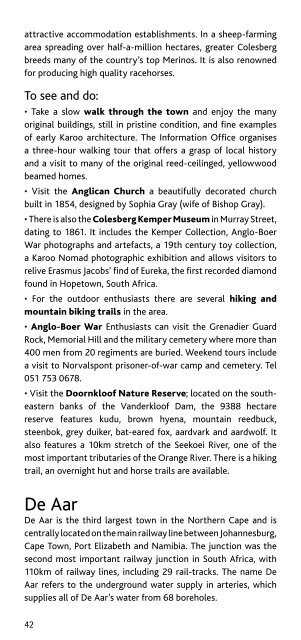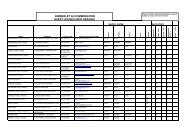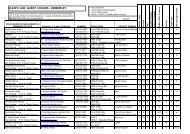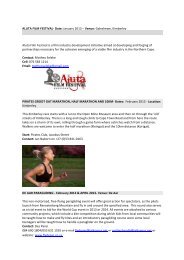NCTA Travel Guide 2012 - Northern Cape Tourism
NCTA Travel Guide 2012 - Northern Cape Tourism
NCTA Travel Guide 2012 - Northern Cape Tourism
Create successful ePaper yourself
Turn your PDF publications into a flip-book with our unique Google optimized e-Paper software.
attractive accommodation establishments. In a sheep-farming<br />
area spreading over half-a-million hectares, greater Colesberg<br />
breeds many of the country’s top Merinos. It is also renowned<br />
for producing high quality racehorses.<br />
To see and do:<br />
• Take a slow walk through the town and enjoy the many<br />
original buildings, still in pristine condition, and fine examples<br />
of early Karoo architecture. The Information Office organises<br />
a three-hour walking tour that offers a grasp of local history<br />
and a visit to many of the original reed-ceilinged, yellowwood<br />
beamed homes.<br />
• Visit the Anglican Church a beautifully decorated church<br />
built in 1854, designed by Sophia Gray (wife of Bishop Gray).<br />
• There is also the Colesberg Kemper Museum in Murray Street,<br />
dating to 1861. It includes the Kemper Collection, Anglo-Boer<br />
War photographs and artefacts, a 19th century toy collection,<br />
a Karoo Nomad photographic exhibition and allows visitors to<br />
relive Erasmus Jacobs’ find of Eureka, the first recorded diamond<br />
found in Hopetown, South Africa.<br />
• For the outdoor enthusiasts there are several hiking and<br />
mountain biking trails in the area.<br />
• Anglo-Boer War Enthusiasts can visit the Grenadier Guard<br />
Rock, Memorial Hill and the military cemetery where more than<br />
400 men from 20 regiments are buried. Weekend tours include<br />
a visit to Norvalspont prisoner-of-war camp and cemetery. Tel<br />
051 753 0678.<br />
• Visit the Doornkloof Nature Reserve; located on the southeastern<br />
banks of the Vanderkloof Dam, the 9388 hectare<br />
reserve features kudu, brown hyena, mountain reedbuck,<br />
steenbok, grey duiker, bat-eared fox, aardvark and aardwolf. It<br />
also features a 10km stretch of the Seekoei River, one of the<br />
most important tributaries of the Orange River. There is a hiking<br />
trail, an overnight hut and horse trails are available.<br />
De Aar<br />
De Aar is the third largest town in the <strong>Northern</strong> <strong>Cape</strong> and is<br />
centrally located on the main railway line between Johannesburg,<br />
<strong>Cape</strong> Town, Port Elizabeth and Namibia. The junction was the<br />
second most important railway junction in South Africa, with<br />
110km of railway lines, including 29 rail-tracks. The name De<br />
Aar refers to the underground water supply in arteries, which<br />
supplies all of De Aar’s water from 68 boreholes.<br />
42<br />
To see and do:<br />
• For bird lovers De Aar is the southern home of the Lesser Kestrel<br />
during summer, having flown in from Europe and Central<br />
Asia. Numbers can peak at more than 10 000 birds in December<br />
and January.<br />
• For paragliding enthusiast the well-established paragliding<br />
school not only offers a thrilling bird’s eye view of the Karoo<br />
landscape, but hosts regular events attracting local and<br />
international paragliders in search of world long-distance<br />
records, for which the local conditions are ideally suited. More<br />
than half of the world’s long-distance records have been set in<br />
De Aar.<br />
• Visit the house of Olive Schreiner, famed author and<br />
feminist who wrote Women and Labour. The house now serves<br />
as a restaurant.<br />
Douglas<br />
The town was founded in 1838 as a mission station on the farm<br />
Backhouse by the Reverend Isaac Hughes. In 1867, a group of<br />
Alabama settlers from Grahamstown signed an agreement<br />
giving them the right to establish a town. It was named after<br />
General Sir Percy Douglas, Lieutenant Governor of the <strong>Cape</strong><br />
Colony. Near the confluence of the Orange River and its main<br />
tributary the Vaal River, Douglas is a thriving, fast-growing<br />
town surrounded by a wealth of agricultural and stock farming<br />
ventures.<br />
To see and do:<br />
• Visit the Douglas Wine Cellars – The cellar was established<br />
www.experiencenortherncape.com 43





